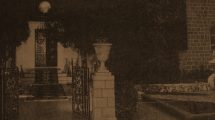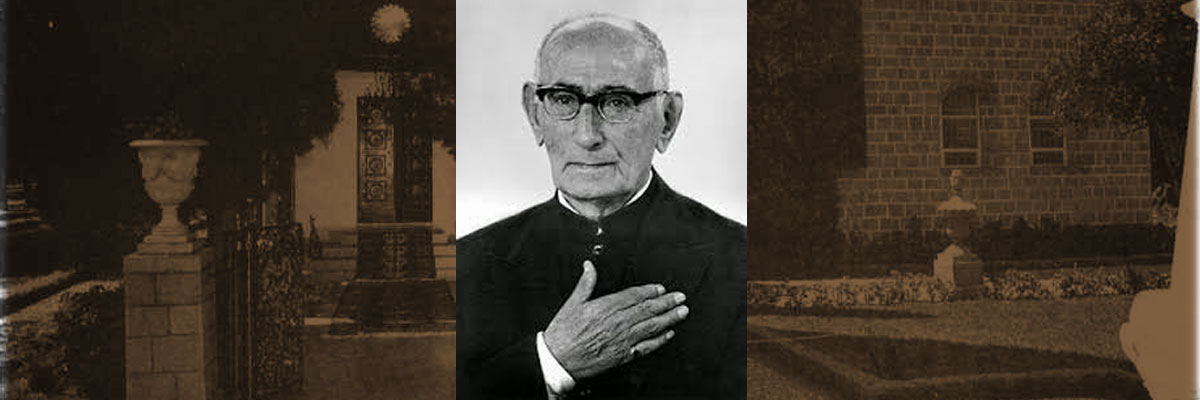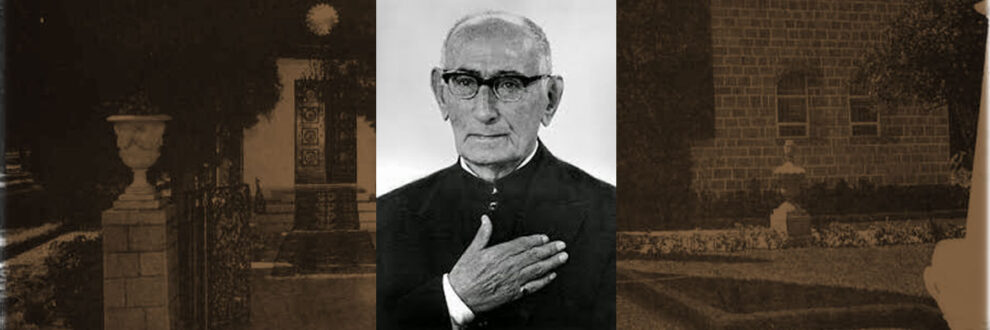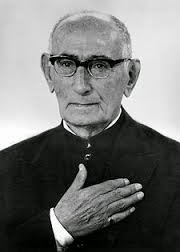 Tarazu’llah Samandari
Tarazu’llah Samandari
Born: October 17, 1874/1875
Death: September 2, 1968
Place of Birth: Qazvin, Iran
Location of Death: Haifa, Israel
Burial Location: Bahá’í Cemetery, Haifa, Israel
Tarazu’llah (Ornament of God) was the name given by Bahá’u’lláh to the son of Samandar, one of the nineteen Apostles of Bahá’u’lláh, and Ma’sumih Khanum Farhadi, both from families of early Babis. ‘Abdu’l-Baha called him Mirza Taraz and bestowed upon him many honorifics including Taraz-i-Ilahi (The Divine Adornment). The beloved Guardian addressed him as Jinab-i-Samandari and appointed him a Hand of the Cause, one of the twelve in the first contingent, on December 24, 1951.
Tarazu’llah Samandari was born in 1874, in Qazvin, Persia, and was brought up by his parents and his grandmother, who was one of the companions of that immortal early heroine of the Faith, Tahirih. His upbringing is described by ‘Abdu’l-Baha, in a prayer revealed for him:
. . . I supplicate before the Throne of Thy mercifulness and the threshold of Thy oneness that Thou mayest rain down Thy manifold confirmations and favours upon this servant of Thine who was born in the cradle of Thy love, nourished from the breast of Thy knowledge, reared in the lap of Thy servitude, nurtured in the bosom of Thy life-giving Faith, until such time as he was fully developed through the outpourings of Thy bounty, attained maturity through Thy loving kindness and turned his face with devotion toward Thy countenance, with his heart wholly centred on Thee and his reliance completely placed in Thee...
The life of Tarazu’llah Samandari, his character and the quality of his service to the Faith, are best described by the pens of ‘Abdu’l-Baha and Shoghi Effendi. ‘Abdu’l- Baha designated him in Tablets as “a luminous candle”, “a cause of happiness of souls”, “a mine of joy”, and “a cause of happiness of hearts”.
The exceptional number of years of Tarazu-‘llah Samandari’s active service commenced in early youth and ceased only with his passing in his ninety-fourth year. His service spanned the last years of the ministry of Bahá’u’lláh, the whole of the ministries of ‘Abdu’l-Baha and Shoghi Effendi, and extended through the period of stewardship of the Hands of the Cause. He lived to witness the election of the Universal House of Justice in 1963 and 1968.
Because educational facilities were limited in the Persia of his childhood, and often denied to the children of Bahá’ís, Tarazu’llah was taught at home by Mulla ‘Ali who was praised by Bahá’u’lláh as the first teacher to put into practice the Bahá’í principles of education. The child learned Persian and Arabic grammar, the simple bookkeeping of that period and calligraphy. At the age of thirteen he entered the office of his father who was a merchant.
 Tarazu’llah became one of the most distinguished calligraphers of Persia. He records that as soon as he could write well he started to copy Tablets and prayers, and this he continued to do his whole life. Many volumes of Scriptures have been copied in his beautiful handwriting. By this means he became well versed in the Bahá’í Writings and could refer to relevant texts on any matter discussed or problem presented to him. The Divine Teachings absorbed and sustained him; he felt no need to refer to other writings. Throughout his long life and wide travels he was always accepted as a highly educated man; not even the learned imagined that he was without formal training. This was perhaps the fulfilment of a prayer revealed for him by ‘Abdu’l-Baha:
Tarazu’llah became one of the most distinguished calligraphers of Persia. He records that as soon as he could write well he started to copy Tablets and prayers, and this he continued to do his whole life. Many volumes of Scriptures have been copied in his beautiful handwriting. By this means he became well versed in the Bahá’í Writings and could refer to relevant texts on any matter discussed or problem presented to him. The Divine Teachings absorbed and sustained him; he felt no need to refer to other writings. Throughout his long life and wide travels he was always accepted as a highly educated man; not even the learned imagined that he was without formal training. This was perhaps the fulfilment of a prayer revealed for him by ‘Abdu’l-Baha:
0 Lord my God! Graciously aid him to attain this glorious bounty and to partake of this rare privilege. Gladden his bosom with the light of Thy knowledge and loose his tongue through the vitalizing breaths of Thy celestial might. Enable him to intone the verses of divine unity in the assemblies of the detached and to chant with sanctified melody in the rose gardens of Thy singleness. Grant him the joy of gazing upon the resplendent light of Thy mercy in the mystic Paradise and enable him to reveal the evidences of Thy grace amongst Thy servants by the manifes- tation in his luminous temple of the signs of Thy bounty...
As a youth the desire of Tarazu’llah’s heart was to gain admittance to the presence of Bahá’u’lláh who was then in exile in the Turkish penal colony of ‘Akka. The pilgrimage of his brother and cousin increased his ardour for meeting his Beloved. This bounty was conferred upon him in 1891 when he made the arduous journey of several weeks from Persia to the Holy Land, accompanied by his sister and his maternal aunt, Hajar Khanum. For six months he was in the entourage of Bahá’u’lláh in ‘Akka and he remained about four weeks after the passing of the Blessed Beauty in 1892. Bahá’u’lláh received him, three days after his arrival, in the House of ‘Abbud, and on other occasions in Bahji, the garden of Ridvan and elsewhere. Bahá’u’lláh has declared that the bounty of gazing once upon the countenance of one’s Lord is equal to the sum total of the charitable deeds of past and future generations. Such a blessing was bestowed upon Taraz Effendi, and on many occasions he shared his memories of this priceless experience, the most memorable time being at the World Congress in London, seventy- two years later (in 1963) when he spoke to nearly 7,000 Bahá’ís from all parts of the world.
During his pilgrimage, he had the supreme honour on two occasions to be in the presence of Bahá’u’lláh at the time of revelation. Although he acknowledged that this experience was impossible to describe, he said the Words poured forth like a mighty torrent, while the greatest majesty was evident in His person. On other occasions, Bahá’u’lláh manifested His own title ” Mazlumiyyih” (Wronged One).
On the morning of Naw-Ruz, Bahh’u’llah sent Taraz Effendi a gift of clothes, a robe, a shirt, a cummerbund and socks. The same day He received the friends in a small garden. The famous poets, Nabil and ‘Andalib, had composed poems for the occasion. The garden was adorned with citrus trees; rain was drizzling. On this day the friends gathered at the Feast had the supreme bounty of hearing Bahá’u’lláh revealing verses. A banquet was served and Taraz Effendi and other friends accompanied the Blessed Beauty on His return to Bahji.
 An account of the celebration of the First Day of Ridvan is given in the words of Tarazu’llah Samandari:
An account of the celebration of the First Day of Ridvan is given in the words of Tarazu’llah Samandari:
“On the First Day of Ridvan, I and three other pilgrims were present, sitting on the floor, facing Bahá’u’lláh, Who was sitting on a chair. He started to chant the Tablet of Sultan with great majesty and grandeur, for about half an hour. He occasionally made a gesture with His hand or moved His foot and the power felt while He was proclaiming ‘O Sultan!’ was overpowering. The spiritual experience, the ecstasy, is beyond description.
“At the end, He said, ‘Taraz Effendi, arise and present a rose each to the friends.’ The roses were spread on a sheet of dazzling whiteness on His bed. I obeyed His command and He said, ‘Give Us Our share also.’ I offered Him a rose and He bade me take one for myself. Then blessing us, He dismissed us from His presence.
“Another Day of Ridvan. He received us in the Garden of Ridvan all friends, residents and pilgrims gathered together with utmost bliss in that Paradise, the envy of all the gardens of the world. The great poet, ‘Andalib, recited an ode he had composed for the occasion. Bahá’u’lláh showered bounties on all present, who were standing before Him in rows, giving them with His own hands rosewater, sweet- meats and oranges and to ‘Andalib, a bottle of rosewater and two oranges!”
One day Tarazu’llah accompanied the beloved Master, ‘Abdu’l-Baha, to Bahji and witnessed His deep reverence in paying homage to His exalted Father. As soon as the windows of the Mansion were visible, He prostrated Himself, bowing His forehead to the ground, although there was a drizzle of rain. Taraz Effendi followed His example.
From Bahá’u’lláh, Tarazu’llah received a clear indication of the station of ‘Abdu’l-Baha as shown by the following incident. After two weeks indisposition, during which time he had not been able to be in the presence of Bahá’u’lláh, Taraz Effendi went to Bahji and meeting one of the children of the Holy Family begged her to ask for permission for him to enter the presence of Bahá’u’lláh. This was granted. Bahá’u’lláh remarked that Tarazu’llah had complained that he had not been in His presence for two weeks, and asked if he had not seen the Master. When he answered, “Yes, my Lord, every evening and every morning,” Bahá’u’lláh asked him, “Then why did you complain that you did not have the reward of pilgrimage?” implying that meeting the Master was as meeting Himself.
He was amongst the pilgrims friends who were summoned to the presence of Bahá’u’lláh while He was lying in bed ill and being attended by His family. His voice was clear, but softer, because of the fever He had contracted; He spoke about the importance of unity.
The irrtensity of the shock of losing his Beloved was so great that Tarazu’llah had no desire to live, but ‘Abdu’l-Baha protected him. He was present with a large number of other pilgrims and resident believers when the Book of the Covenant was read. ‘Abdu’l-Baha instructed the pilgrims to relate all they had witnessed on their return to Persia. Taraz Effendi departed about four weeks later, travelling through Turkey to avoid an area of cholera. The journey was on mules and the homebound pilgrims met the believers en route.
Taraz Effendi received permission to make another pilgrimage in 1898. With a group of friends from Persia he stayed in ‘Akka for four months and ten days, in the society of ‘Abdu’l-Baha, gaining in spirituality and knowledge.
Several times he begged ‘Abdu’l-Baha for martyrdom, but the Master told him he must live to serve the Faith with the spirit of martyrdom, saying: Be sure, whatever I have desired for Myself, I have desired for you
One day, “Abdu’l-Baha with about eighty friends, proceeded from the Garden of Ridvan to the Shrine of Bahá’u’lláh in procession, each one carrying a pot of flowers and chanting odes and poems in praise of the Blessed Beauty. ‘Abdu’l-Baha told them this would be commemorated in the future by kings coming with bared heads and bare feet, carrying jewelled pots of Bowers.
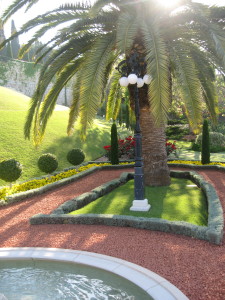 In 1908, Taraz Effendi made a third pilgrimage in a period when conditions in the Holy Land were very unsettled; ‘Abdu’l-Baha’s life was in danger and the enemies of the Faith were emboldened by events which seemed momentarily to assure their ascendancy. Taraz Effendi was given a Bahá’í ring by the Master and shown a long scroll on which were inscribed the names of four hundred believers of America, with their declaration of loyalty to ‘Abdu’l-Baha and the Covenant. On the last day of pilgrimage ‘Abdu’l-Baha gave him an envelope containing a Tablet for the friends in Persia, and the scroll from America, with the instruction that he and his companion should visit the communities and call the believers together in groups of nine, and ask them to make a covenant of unity in the Covenant of Bahá’u’lláh, explaining to them that the loss of each soul is the loss of all, the gain of one, the gain of all; each should be ready to sacrifice for the others. Each of the nine should, in turn, make a covenant with another group of nine. The original scroll from America is now in safekeeping at the World Centre.
In 1908, Taraz Effendi made a third pilgrimage in a period when conditions in the Holy Land were very unsettled; ‘Abdu’l-Baha’s life was in danger and the enemies of the Faith were emboldened by events which seemed momentarily to assure their ascendancy. Taraz Effendi was given a Bahá’í ring by the Master and shown a long scroll on which were inscribed the names of four hundred believers of America, with their declaration of loyalty to ‘Abdu’l-Baha and the Covenant. On the last day of pilgrimage ‘Abdu’l-Baha gave him an envelope containing a Tablet for the friends in Persia, and the scroll from America, with the instruction that he and his companion should visit the communities and call the believers together in groups of nine, and ask them to make a covenant of unity in the Covenant of Bahá’u’lláh, explaining to them that the loss of each soul is the loss of all, the gain of one, the gain of all; each should be ready to sacrifice for the others. Each of the nine should, in turn, make a covenant with another group of nine. The original scroll from America is now in safekeeping at the World Centre.
During many of his visits to ‘Abdu’l-Baha at this time, he would hear of the importance of detachment and service to the Cause. This was in preparation for the announcement by ‘Abdu’l-Baha that when Taraz Effendi returned to Persia it should not be to work any longer in his father’s office, but to spend his time travelling throughout the country, teaching and increasing the knowledge of the friends. ‘Abdu’l-Baha told him that he should go on His behalf, like Himself, with detachment and enkindled merit – as a globe of fire.
After a pilgrimage of forty days Taraz Effendi returned to Persia where he met his appointed partner for his journeys, Mr. ‘Ali Akbar Rafsanjani. They spent some months in Tihran learning from a Bahá’í doctor rudiments of medicine sufficient to enable them to deal with simple ailments. This was done to facilitate their journeys throughout Persia. Only two years previously a severe outbreak of persecutions had afflicted the Persian Bahá’í community and the enemies of the Cause were still ready to create trouble for the believers. The utmost wisdom had to be exercised. Against this background the pair embarked on a journey which was to last for five years and take them to many places in Turkistan and Persia, including remote villages. They travelled by mule, donkey, horse-drawn carriage and often on foot, always at the risk of attack by highwaymen. They were confirmed in carrying out ‘Abdu’l-Baha’s instructions. A new life of activity came into existence. In many of His Tablets, ‘Abdu’l-Baha expressed His satisfaction at these journeys and encouraged other friends to follow in their footsteps in spreading the Teachings.
Around 1895, Taraz Effendi married his second cousin whose name, Taraziyyih, was the feminine form of his own. She had been born a few months after him and had been given the name chosen by Bahá’u’lláh. She was a Farhadi, being related to his mother. During the lengthy journey of her husband ‘Taraziyyih received a beautiful Tablet from ‘Abdu’l-Baha offering consolation in their separation and praying that this temporary separation would be the cause of eternal reunion; whereas other unions end in separation, unity of spiritual aspiration and service elevated a marriage to the station of a real union, a meeting that has no end.
Tarazu’llah Samandari writes about one of his happiest experiences when his wife was instrumental in opening a Bahá’í school for girls in Qazvin (Tavakkul), at a time when he was teaching in Shiraz. It is recorded in his notes that the news flooded him with “a new life and immeasurable joy; I raised my hands to thank ‘Abdu’l-Baha, and tears of happiness streamed from my eyes, that my life-partner had received this confirmation.” Taraziyyih acted as principal of the school which was the result of the combined efforts of the friends in Qazvin. ‘The school became a means of establishing a firm and dignified relationship between Bahá’ís amid others and attracted the daughters of even the most fanatical elements of the town. Taraziyyih received another Tablet from ‘Abdu’l-Baha in which He bestowed words of praise and encouragement and promised that she would be showered with endless bounties from every direction.
While Tarazu’llah Samandari was in Shiraz in 1909, the enemies of the Faith attacked the Bahá’ís of Nayriz and despoiled their property. Eighteen Bahá’ís suffered martyrdom. Through the activity of Taraz Effendi and ‘Ali Akbar Rafsanjani, and with the help of influential friends, the refugees were returned to their homes and the community resettled. It was at this very time that, on Mt. Carmel, ‘Abdu’l-Baha laid to rest the earthly remains of the Bab in the mausoleum He had constructed, that sacred dust having been in concealment and moved from place to place for a period of sixty years. In a Tablet written shortly thereafter to one of the friends in Persia ‘Abdu’l-Baha said that although the martyrdom of the friends was the cause of His shedding tears and was a heart-burning grief, the spiritual significance of the death of those innocent friends was a great bounty of God and a source of joy in the Abha Kingdom. ‘Abdu’1-Baha consoled the hearts of the Persian friends by saying that on the day the remains of the Bab were interred on Mt. Carmel a cablegram had been received from the believers in America announcing that a site had been selected for the construction of the first Bahá’í Temple of the ‘West.
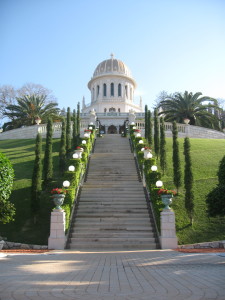 At the end of 1909 and beginning of 1910, their, five-year teaching journey behind them, ‘Ali Akbar Rafsanjani and Taraz Effendi travelled to the Holy Land through Bombay and spent two months in the presence of ‘Abdu’l-Baha who showered them with love and expressed the utmost appreciation of their devoted services which, He said, would never be effaced from the hearts and memories of the friends who had met them. Because of his poor health, Tarazu’llah Samandari was advised to return to Qazvin where he remained for approximately seventeen years during which he taught aclively, carried on a wide correspondence with many Bahá’í centres, served as secretary of the Spiritual Assembly, produced a Bahá’í newsletter which was circulated wherever Persian was read, and, at the instruction of the Guardian, he engaged in copying and verifying the authenticity of the countless Tablets revealed to the friends in Persia during the Heroic Age of the Faith, a task which required his close supervision for two years and resulted in the compilation of eighteen volumes of these priceless documents, One copy was sent to the Holy Land and one to the Spiritual Assembly of Tihran.
At the end of 1909 and beginning of 1910, their, five-year teaching journey behind them, ‘Ali Akbar Rafsanjani and Taraz Effendi travelled to the Holy Land through Bombay and spent two months in the presence of ‘Abdu’l-Baha who showered them with love and expressed the utmost appreciation of their devoted services which, He said, would never be effaced from the hearts and memories of the friends who had met them. Because of his poor health, Tarazu’llah Samandari was advised to return to Qazvin where he remained for approximately seventeen years during which he taught aclively, carried on a wide correspondence with many Bahá’í centres, served as secretary of the Spiritual Assembly, produced a Bahá’í newsletter which was circulated wherever Persian was read, and, at the instruction of the Guardian, he engaged in copying and verifying the authenticity of the countless Tablets revealed to the friends in Persia during the Heroic Age of the Faith, a task which required his close supervision for two years and resulted in the compilation of eighteen volumes of these priceless documents, One copy was sent to the Holy Land and one to the Spiritual Assembly of Tihran.
About six years after the passing of ‘Abdu’l- Baha, at the suggestion of the Spiritual Assem- bly of Tihran and with the full approval of Shoghi Effendi, who, in a letter written in November, 1927, addressed him as a “strong pillar” and an outstanding example of “obedience and dedication”, Tarazu’llah Samandari resumed travel teaching. In that same month he journeyed with his wife and youngest son to Adhirbayjan, after which he never had a settled home anywhere. The remaining forty-one years of his life were spent in travelling and teaching.
Space does not permit giving, even in outline, an account of his activities during these years; his own diary records them and reflects his dedication, self-sacrifice, detachment and the enthusiasm and joy he derived from service to the Cause of God. The nature and value of his contribution in this period is best illustrated by a few brief extracts from the many letters he received from the beloved Guardian:
” April 24,1928
… Verily, thou art a faithful custodian of the fortified citadel and a dedicated servant and promoter of the religion of the Lord. Thou art in the foremost rank of teachers …November 1,1928
. . . The brilliant, the continuous and sincere services of that chosen one of the Lord of all beings are engraved on my heart and inscribed in permanent characters in the records of the Abha Kingdom; the passage of ages and centuries cannot efface them. . .”
In subsequent communications Shoghi Effendi addressed him as “an Apostle of the Crimson Ark”, a “strong pillar of the luminous Faith of God”, and a “Knight of the arena of detachment” (June 19, 1933); a “foremost exemplar for the righteous” and “a true herald of the Greatest Name” (October, 1934); “the most distinguished of friends” (December 22, 1939); and “the shining lamp among Bahá’í teachers” (December 25, 1940).
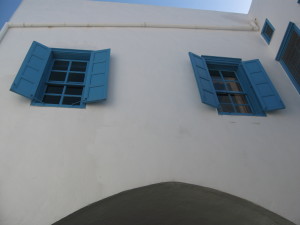 For a few months in 1933, at the request of the Central Spiritual Assembly of Tihran, Taraz Effendi managed the national office, dealing with correspondence and receiving visitors, but the beloved Guardian requested him to resume his journeys. In the autumn of 1940 he and his wife were granted permission to make the pilgrimage to the Holy Land. During the fifty days spent there Shoghi Effendi surrounded them with kindness and made use of Tarazu’llah Samandari’s ability by giving him a number of original Tablets to identify. When Tarazu’llah referred to his age and weakened health preventing him from serving as he had before, the Guardian replied that the “first” period of his service had terminated and gave him the responsibility of encouraging the friends of Persia to pioneer to nearby countries. On their return journey they were asked to visit various communities. On his arrival in Tihran, he immediately met the National Spiritual Assembly. A pioneer committee was formed and through his encouragement a number of believers arose to establish the Faith in other areas.
For a few months in 1933, at the request of the Central Spiritual Assembly of Tihran, Taraz Effendi managed the national office, dealing with correspondence and receiving visitors, but the beloved Guardian requested him to resume his journeys. In the autumn of 1940 he and his wife were granted permission to make the pilgrimage to the Holy Land. During the fifty days spent there Shoghi Effendi surrounded them with kindness and made use of Tarazu’llah Samandari’s ability by giving him a number of original Tablets to identify. When Tarazu’llah referred to his age and weakened health preventing him from serving as he had before, the Guardian replied that the “first” period of his service had terminated and gave him the responsibility of encouraging the friends of Persia to pioneer to nearby countries. On their return journey they were asked to visit various communities. On his arrival in Tihran, he immediately met the National Spiritual Assembly. A pioneer committee was formed and through his encouragement a number of believers arose to establish the Faith in other areas.
In 1944 he was asked to go to Shiraz to protect the Faith from mischief-makers and he remained there a number of years. During this time his wife died at her pioneer post in Zanjan, Persia, not having seen her husband for three years. At her death on November 7, 1947, the Guardian wrote a moving letter of consolation praising the services of “that dear handmaiden of the Ancient Beauty”, who had engaged in “spreading the Word of God . . . with absolute detachment and steadfastness.” She resides now, he wrote, “in the loftiest mansions of heaven”.
An outstanding service which he rendered in this period was the securing of the original manuscript of the Kitab-i-Iqan which he sent to the Holy Land. His intercontinental travels commenced shortly after his appointment as a Hand of the Cause in 1951 and took him to the Far East and the West. He attended all four Intercontinental Conferences at the opening
After attending the funeral of the beloved Guardian in London in 1957 he journeyed to the Holy Land to attend the conclave of the Hands of the Cause and was present at all subsequent conclaves. During these visits he was able to identify a large number of Tablets.
In subsequent years he travelled extensively in Africa, the Middle East, the Far East and Asia, traversing the globe as in an earlier period he had traversed his homeland from hamlet to hamlet. A new generation of Bahá’ís felt themselves blessed to be in his presence at the World Congress in London in 1963.
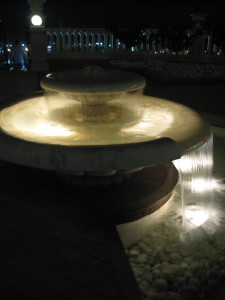 The celebration of the centenary of Bahá’u’lláh’s proclamation of His Message in September/October, 1867, to the kings and ru lers of the world opened with a visit in September, 1967, by a few appointed representatives of the Bahá’í world to the site of the house in Adrianople where the historic Suriy-i-Mulhk was revealed; Tarazu’llah Samandari was one of the Hands of the Cause who participated in “this joyful and pious act”. Immediately thereafter he travelled to the United States to represent the Universal House of Justice at the Intercontinental Conference in Wilmette. He was now ninety-two years old. His presence in the conference was deeply appreciated and inspired the 3,000 or more friends gathered to hear the only surviving Hand of the Cause whose eyes had been blessed by beholding Bahá’u’lláh, and his ears by hearkening to His Words. In spite of the cold he welcomed the programme for his tour of Alaska, Canada, the United States, England and Germany. In America he was able to meet thousands of friends in special conferences held in key towns where friends from outlying areas would gather. The Faith was proclaimed by means of press and radio interviews, public meetings and addresses in universities. A remarkable degree of respect was shown him by members of the press, all of whom extended the length of the interviews; in reality, it was the Hand of the Cause himself who conducted these gatherings and the atmosphere was always sympathetic.
The celebration of the centenary of Bahá’u’lláh’s proclamation of His Message in September/October, 1867, to the kings and ru lers of the world opened with a visit in September, 1967, by a few appointed representatives of the Bahá’í world to the site of the house in Adrianople where the historic Suriy-i-Mulhk was revealed; Tarazu’llah Samandari was one of the Hands of the Cause who participated in “this joyful and pious act”. Immediately thereafter he travelled to the United States to represent the Universal House of Justice at the Intercontinental Conference in Wilmette. He was now ninety-two years old. His presence in the conference was deeply appreciated and inspired the 3,000 or more friends gathered to hear the only surviving Hand of the Cause whose eyes had been blessed by beholding Bahá’u’lláh, and his ears by hearkening to His Words. In spite of the cold he welcomed the programme for his tour of Alaska, Canada, the United States, England and Germany. In America he was able to meet thousands of friends in special conferences held in key towns where friends from outlying areas would gather. The Faith was proclaimed by means of press and radio interviews, public meetings and addresses in universities. A remarkable degree of respect was shown him by members of the press, all of whom extended the length of the interviews; in reality, it was the Hand of the Cause himself who conducted these gatherings and the atmosphere was always sympathetic.
Taraz Effendi was an arresting figure- small, trim, upright, with quick movements- and he walked so swiftly that few could keep pace with him. His eyes were penetrating and dark, his hair neat and black (it never became quite white), his hands strong and sensitive and his voice clear and resonant. His rapidity of move- ment and mental agility remained with him to the end of his life. He personified courtesy, dignity and kindliness.
He was a very early riser and neat and methodical in his ways. Coming from a background where women were veiled and transport was primitive, he was able to adapt himself to life in modern America, while retaining his innate dignity. He had some attractive, old-fashioned habits, such as keeping his prayer books and Scriptures wrapped in silk squares or in little cotton bags; and he kept his clothes, which were neat and simple and limited in number because of the long years of continuous travel, neatly folded and wrapped in cotton squares.
He rested only to gain strength to work and was always ready to serve others. Children and youth were drawn to him. Generations of youth inspired by his encouragement and example have matured as ardent, active Bahá’ís acknowledging that it was he who set them on the path of service.
As age drew on him he would say with a smile, ” Different organs of my body are trying to resign, one by one. I tell them: ‘I won’t accept this! As you came together, you must leave together!’ ” His wish was fulfilled; his mind was lucid, his sight clear, his voice ringing, his hearing sharp, his step firm and swift, his hand steady and his spirit radiant until the end.
Although barely recovered from a serious illness which had stricken him but a short time before, Mr. Samandari came to the Holy Land in late August, 1968, to attend the centenary commemoration of BahL’u’llah’s arrival on those shores. Here Taraz Effendi’s health deteriorated and he was taken to the hospital where many friends visited him and found his radiance undimmed. He survived to see the day commemorating the arrival of Bahá’u’lláh and peacefully passed away on September 2, 1968.
Source:
The Bahá’í World. Kidlington, Oxford: George Ronald Publisher. Volume III, p. 80
-Permission given by George Ronald, Publishers
Images:
Baha’i World Centre Archives
(c) Baha’i Chronicles

